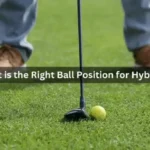Have you ever heard the term “provisional” while playing a round of golf and wondered what it meant? A provisional in golf is a concept that every golfer should be familiar with, as it can save you time and strokes on the course.
In this article, we will explore what a provisional is, when you should consider playing one, and the correct way to do it on the course.
What Is A Provisional In Golf?
A provisional in golf refers to a second ball played by a golfer when there is doubt about the status or location of their first ball. This typically occurs when a player believes their initial shot may be lost outside a water hazard or out of bounds. By declaring and playing a provisional ball, the player ensures that they have a viable alternative if the first ball cannot be found or is deemed unplayable.
When playing a provisional ball, it is crucial for the player to announce their intention to do so before playing the second shot. This declaration is essential to distinguish between the provisional ball and the original ball should they be discovered in close proximity to each other. Failing to declare a provisional before playing it may result in penalties under the Rules of Golf.
Importance of Provisionals in Golf
Provisionals play a vital role in maintaining the pace of play on the golf course. Rather than spending an extended period searching for a potentially lost ball, players can quickly proceed by hitting a provisional shot. This helps prevent unnecessary delays for both the player and fellow golfers on the course.
Additionally, provisionals provide a sense of security for golfers, especially in high-pressure situations such as tournament play. Knowing that there is a backup ball in play can alleviate concerns about the outcome of a wayward shot and allow players to focus on their subsequent shots with more confidence.
From a strategic standpoint, playing a provisional ball allows golfers to avoid the significant time and distance penalties associated with losing a ball. Instead of returning to the original spot to play another shot, the player can continue the round with the provisional ball, minimizing the impact on their overall score.
When and How to Play a Provisional Shot in Golf
Playing golf can be both challenging and rewarding, with each shot requiring careful consideration and strategy. One important aspect of the game that every golfer should be familiar with is when and how to play a provisional shot. A provisional shot comes into play when a player believes their original shot may be lost or out of bounds. Understanding the rules and tactics behind playing a provisional shot can help golfers save strokes and stay competitive on the course.
When to Play a Provisional Shot
Knowing when to play a provisional shot is crucial in order to avoid penalties and keep the game moving smoothly. A provisional shot should be played when there is a possibility that the original ball has gone out of bounds, into a penalty area, or may be lost. It is important to remember that a provisional ball can only be played from the same spot as the original ball.
How to Declare and Play a Provisional Shot
When playing a provisional shot, it is essential to follow the proper procedure to avoid any confusion or penalties. To declare a provisional shot, announce to your playing partners that you intend to play a provisional ball in case the original cannot be found. It is important to do this before moving forward to search for the original ball.
Next, when playing the provisional shot, use a different ball from the original. This ball will be considered the provisional ball until it is determined whether the original ball is lost or out of bounds. Ensure that the provisional ball is played from the same spot or as close to the original spot as possible. Remember, the provisional ball is in play until it is determined that the original ball is playable.
Rules and Penalties
According to the Rules of Golf, if a player fails to play a provisional ball when required and the original ball is not found, the player must return to the spot of the previous shot, resulting in a one-stroke penalty. Understanding and following the rules regarding provisional shots can help prevent unnecessary penalties and ensure fair play on the course.
Common Scenarios Where Provisional Shots Are Necessary in Golf
Provisional shots in golf are often a crucial element of the game, especially in specific scenarios where players need to take an additional shot to avoid penalties or speed up play. Let’s delve into some common scenarios where provisional shots are necessary in golf.
When a Shot is Likely Lost
One common scenario where a provisional shot is required is when a player suspects that their ball may be lost or out of bounds. This situation often occurs when a shot is hit towards a dense rough, thick bushes, or near water hazards. By playing a provisional shot before searching for the original ball, players can save time and avoid the risk of incurring penalty strokes for a lost ball.
When Playing Into Blind Areas
In golf, blind shots refer to situations where players cannot see the landing area or the target due to obstructing bunkers, hills, or doglegs. When playing into blind areas, it is prudent to hit a provisional shot in case the original ball ends up in a hazard or out of bounds. This preemptive action ensures that the player has a backup plan if the original shot does not turn out as expected.
When Doubt Exists About a Ball’s Playability
Sometimes, a player may hit a shot that could potentially end up in a challenging or unfavorable position on the course. In such cases, playing a provisional shot allows the player to explore various options without committing to the initial shot. By hitting a provisional ball, the player can assess the situation of both balls and choose the better position to continue play effectively.
When Speeding Up Play
Provisional shots are also beneficial for maintaining a good pace of play on the golf course. If a player’s original shot may have landed in a hard-to-find area or requires extensive search time, playing a provisional ball expedites the gameplay by allowing the player to continue without delay. This practice is essential in ensuring that rounds are completed within a reasonable timeframe.
When Facing Penalty Situations
In instances where a player faces penalty strokes for hitting a shot out of bounds or into a hazard, playing a provisional shot can potentially save strokes. By hitting a provisional ball, the player provides themselves with a safety net in case the original shot results in a penalty. This strategic move can prevent unnecessary score inflation and help maintain a competitive edge during the round.
Tips for Success When Playing Provisional Shots in Golf
Focus on Distance and Accuracy
When playing a provisional shot, focus on hitting it with sufficient distance to put yourself in a favorable position, while also ensuring accuracy to avoid compounding the issue. It is advisable to aim for a safer target rather than attempting a risky shot that could lead to further trouble. Maintaining composure and executing a controlled swing is key to achieving the desired outcome.
Stay Positive and Maintain Focus
Playing a provisional shot can be a stressful situation, but it is essential to stay positive and maintain focus. Keep a clear mind, trust your abilities, and approach the shot with confidence. Dwelling on the mistake that led to playing a provisional ball will only hinder your performance. Stay in the present moment and give your best effort on the shot at hand.
Seek Professional Guidance
If you find yourself frequently in situations where you need to play provisional shots, consider seeking guidance from a golf instructor or coach. They can help you improve your overall game, including course management skills, shot selection, and decision-making under pressure. Working with a professional can enhance your understanding of when to play provisional shots and how to execute them effectively.
FAQS
Q: Why take a provisional instead of a drop?
A: Taking a provisional ball instead of a drop is beneficial because it saves time if the original ball is lost or out of bounds. By playing a provisional ball, you avoid the need to walk back to the original spot to play again after a lost ball is confirmed. A provisional keeps the game moving smoothly, particularly in cases where the original ball might be difficult to find.
Q: Can you hit a provisional ball from the tee?
A: Yes, you can hit a provisional ball from the tee if you believe your original ball might be lost outside a penalty area or out of bounds. This is done under Rule 18.3 to maintain the pace of play and manage potential lost ball penalties.
Q: What happens if you find your original ball?
A: If you find your original ball in bounds within three minutes of starting your search, you must continue play with the original ball. The provisional ball is then abandoned and does not count towards your score.
Q: How many strokes does a provisional ball cost?
A: Playing a provisional ball itself does not initially cost any extra strokes; however, if the provisional ball ends up being used because the original is lost or out of bounds, you must count all the strokes with the provisional ball plus a penalty stroke. Essentially, it puts you at one additional stroke compared to where your score would have been if the original ball was played successfully.







